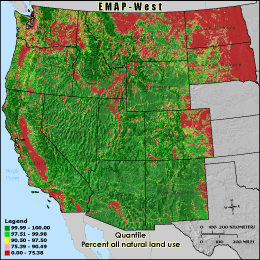|
|
Methodology and Interpretation
N_INDEX - Percent all natural land use
The N-Index (all natural use index) metric is the percentage of land cover
cells located within the 3 km grid cell reporting unit that are classified as
either forest, shrub land, grassland, wetland, or bare rock to the total number
of cells inside the grid cell boundary minus those cells classified as water
(total land area). This gives the proportion of land area in the grid cell that
is in a natural state, but provides no information on the health of the vegetation
cover. The N-index shows areas in which land use practices could have less
disturbance from human use and is usually the inverse of the U-Index. The values
seen here in the mountain area are generally much higher compared
to the central and eastern United States.


Quantile: Each class contains an approximately equal number (count) of features. A quantile
classification is well-suited to linearly distributed data. Because features are grouped by the number
within each class, the resulting map can be misleading, in that similar features can be separated into
adjacent classes, or features with widely different values can be lumped into the same class. This
distortion can be minimized by increasing the number of classes.
Natural Breaks: Classes are based on natural groupings of data values. Natural break points
are identified by looking for groupings and patterns inherent in the data. The features are divided
into classes whose boundaries are set where there are relatively large jumps in the distribution of
data values.
* EMAP-West Landscape Metrics Metadata (FGDC)
|
|

